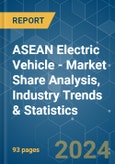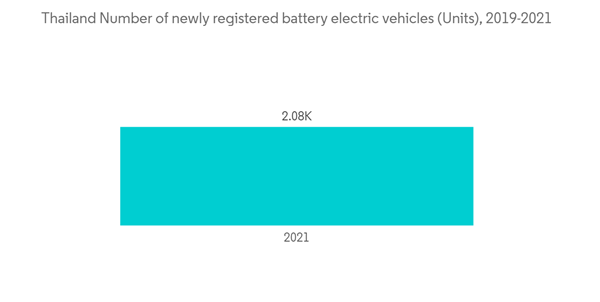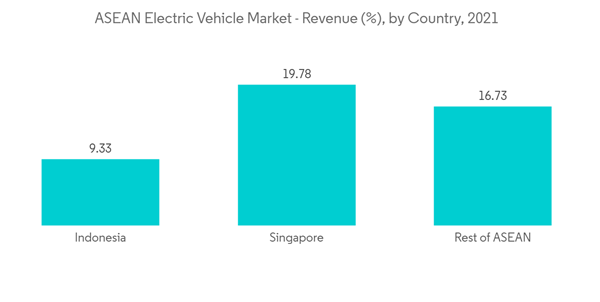As a result of the COVID-19 pandemic, manufacturing activities ceased for several months in the first half of 2020. Also, the disrupted supply chain and the shortage of chips in 2021 hurt the growth of the market studied. However, the automotive industry is now recovering from the losses and paving the way to introduce quality products to cater to the rising demand from consumers across the country. The automotive industry witnessed significant growth in terms of production in 2021, which is likely to increase the demand for electric vehicles across the country.
Government policies to support the growth of electric vehicles and plans to enlarge the electric vehicle charging infrastructure are expected to remain prominent market drivers during the forecast period. Several governments across the ASEAN region have announced plans to have a certain portion of their new vehicle sales electrified in the coming few years.
Governments play a vital role in encouraging the expansion of electric vehicle charging infrastructure. As ASEAN governments push for further vehicle electrification, there must be usage and purchase incentives that either lower the overall cost of ownership or make driving electric vehicles more convenient for customers. Although only a few incentives for purchasing electric vehicles or charging infrastructure are present in the Philippines, the country holds 5% and 4% of worldwide nickel and cobalt reserves, respectively, and has enormous potential to participate more actively in the EV battery production value chain.
EVs are becoming more popular in Indonesia, owing to ride-hailing companies like Grab, which announced a cooperation with the local power supplier PLN to expand its fleet charging infrastructure. In the coming years, public transportation operators such as Transjakarta want to increase their electric bus fleet to 10,000 units. Such instances are signs of the growth of the electric vehicle market across the region.
ASEAN EV Market Trends
Battery Electric Vehicle is Dominating the Market
Electric mobility is rapidly growing across the world, owing to which goods transportation companies are also converting their existing fleet into electric propulsion-based vehicles.Growing consumer preference for fuel-efficient electric vehicles (EVs), self-driving cars, and vehicle-to-vehicle communication technology are expected to boost market growth during the forecast period.
Furthermore, regulatory bodies in ASEAN countries have laid down stringent regulations about bringing down fuel emissions and increasing road safety. This has brought the entire ASEAN automotive industry to experience the same effect in the adoption of the EV segment for its growing automotive fleet.
Key automakers with robust infrastructure layouts and manufacturing capabilities have historically paved the way for this transition, enabling the strong potential for growth of BEV during the forecast period.
It has been estimated that nearly 54% of new car sales and 33% of global car fleets are expected to be electric by 2040. Out of it, more than 50% will be battery-electric. The ASEAN region is one of the prominent hotspots for sales of the automotive fleet and is expected to witness proliferating growth during the same period. The governments of various countries are providing support to increase electric mobility to minimize pollution. Moreover, an increase in electric mobility is likely to increase the sales of battery electric vehicles.
For instance, in March 2022, Thailand's government adopted new government incentives to accelerate the transition to electric vehicles. The incentives are part of the Thai government's plan to convert half of the country's total car production to electric vehicles by 2030. Indonesia plans to electrify 20% of its new vehicles by 2025. Additionally, the country aims for electric vehicles to account for 20% of total exports by 2025.
Based on the aforementioned factors, growing investments in electric vehicle manufacturing and the government's EV-supporting policies are likely to drive the ASEAN electric vehicle market during the forecast period.
Singapore Expected to Play a Key Role
Singapore has been at the forefront of EV charging infrastructure in ASEAN, with more than 1,800 public charging points available. The Government of Singapore plans to install 60,000 more charging points by the end of 2030.The Singapore government has set a new target of USD 22 million between 2021 and 2025 to promote EV adoption among consumers. This will increase the number of chargers on private properties to strengthen the charging infrastructure. In tandem, Singapore has successfully established itself as the key R&D hotspot for its EV industry. This, in turn, has been done by facilitating investment projects from several multinationals and start-up companies to build a strong local EV ecosystem in Singapore.
The Government of Singapore provides support to increase electric mobility to minimize pollution. Moreover, an increase in electric mobility is expected to increase electric vehicle sales. For instance, by 2040, Singapore has planned to phase out its internal combustion engines and replace them with cleaner energy vehicles. The newly founded National Electric Vehicle Centre (NEVC) is heading the campaign to promote wider EV adoption, with Singapore's objective for vehicles to run on green energy by 2040. This enables Singapore to develop new EV-related technologies safely and innovatively.
ASEAN EV Industry Overview
Due to the entry of various electric vehicle ride-hailing startups and automakers, the ASEAN electric vehicle market is dominated by several active players, including new startups and ICE vehicle OEMs. Some of the major players in the market include Hyundai, Tesla Inc., BMW Group, MG Motors, and Mitsubishi Motor Company. The local governments are preparing for scaling up local electric vehicle production, and various automotive and ride-hailing companies are forming strategic alliances with other players in the market. For instance,- In September 2022, BYD announced its first electric car manufacturing plant in Thailand. The company will start manufacturing operations in 2024 with an annual production capacity of about 150,000 electric vehicles.
- In March 2022, Hyundai Motor Group launched its new automotive plant in Indonesia that will produce the first locally assembled electric vehicle. This initiative is part of President Joko Widodo's goal of developing a full EV supply chain in Indonesia.
- In March 2022, Mitsubishi Motors Corporation signed a memorandum of understanding with four companies, namely PT Pos Indonesia, PT Haleyora Power, Go-Jek, and DHL Supply Chain Indonesia. The project aims to conduct a pilot study on the use of electric commercial vehicles.
- In 2021, the Asian Development Bank and Energy Absolute signed a USD 48 million green loan agreement to finance countrywide electric vehicle charging infrastructure in Thailand.
- In 2020, Thailand's government announced a new roadmap to promote EVs through various state agencies. It has set an aggressive target to manufacture around 250,000 EVs, of which 3,000 are electric buses and 53,000 electric motorcycles, by 2025.
Additional Benefits:
- The market estimate (ME) sheet in Excel format
- 3 months of analyst support
This product will be delivered within 2 business days.
Table of Contents
Companies Mentioned (Partial List)
A selection of companies mentioned in this report includes, but is not limited to:
- Toyota Motor Corporation
- Honda Motor Company Limited
- BMW Group
- Hyundai Motor Company
- Mitsubishi Motors Corporation
- MG Motor
- STAR 8 Company Limited
- BYD Co. Ltd
- Nissan Motor Company
- Audi AG
- AB Volvo
- Tesla Inc.
- BYD Company Limited
Methodology

LOADING...










